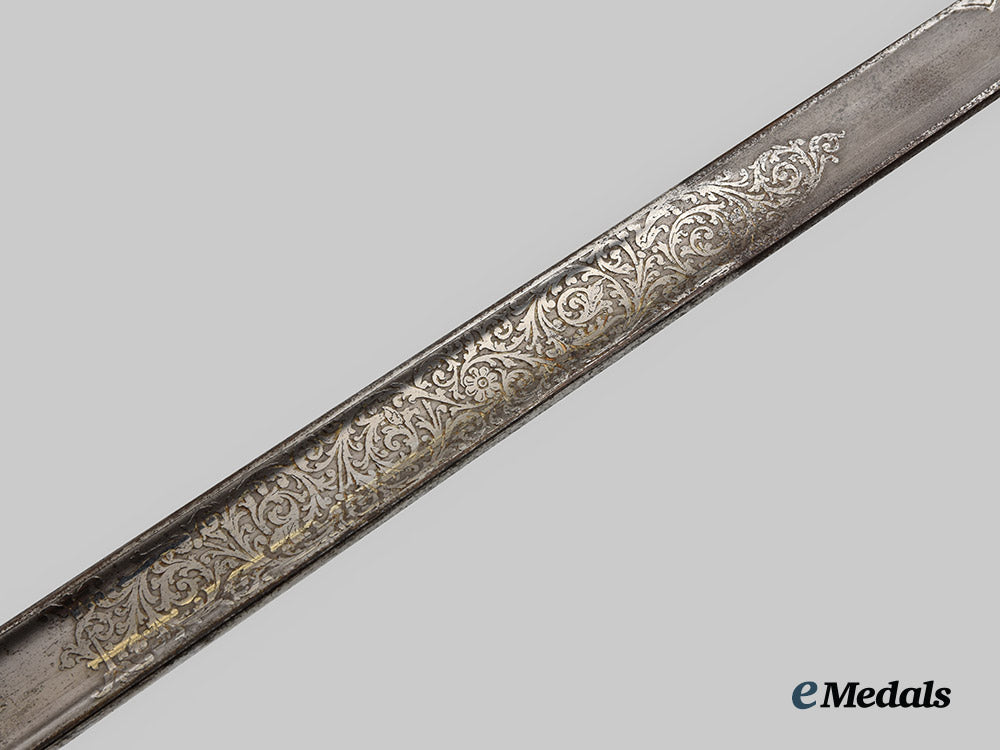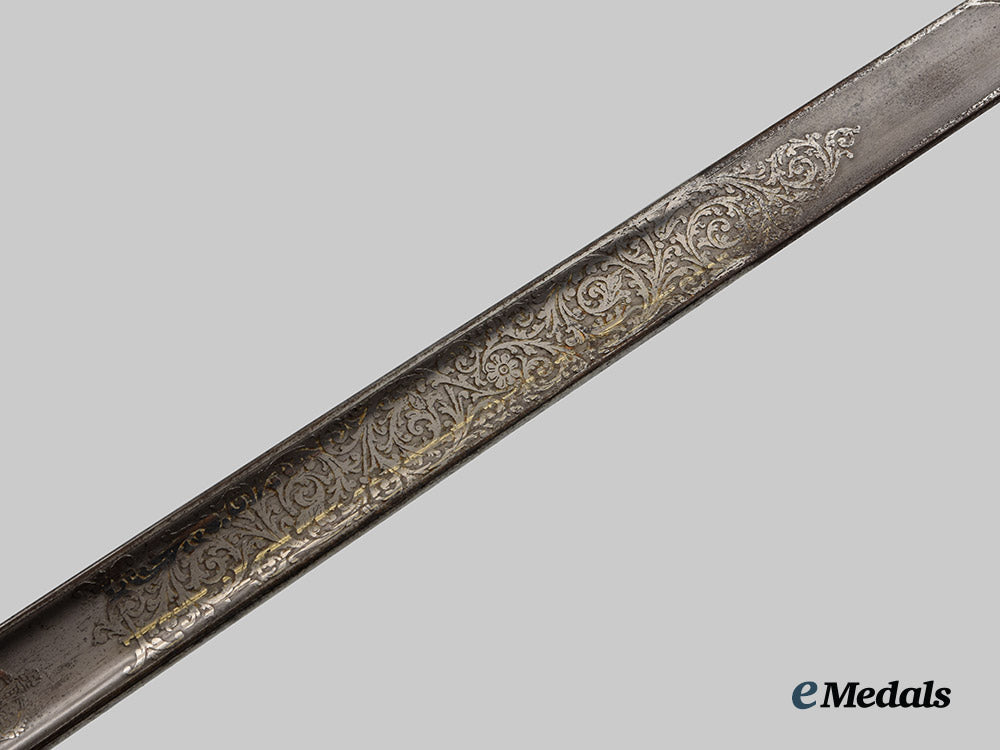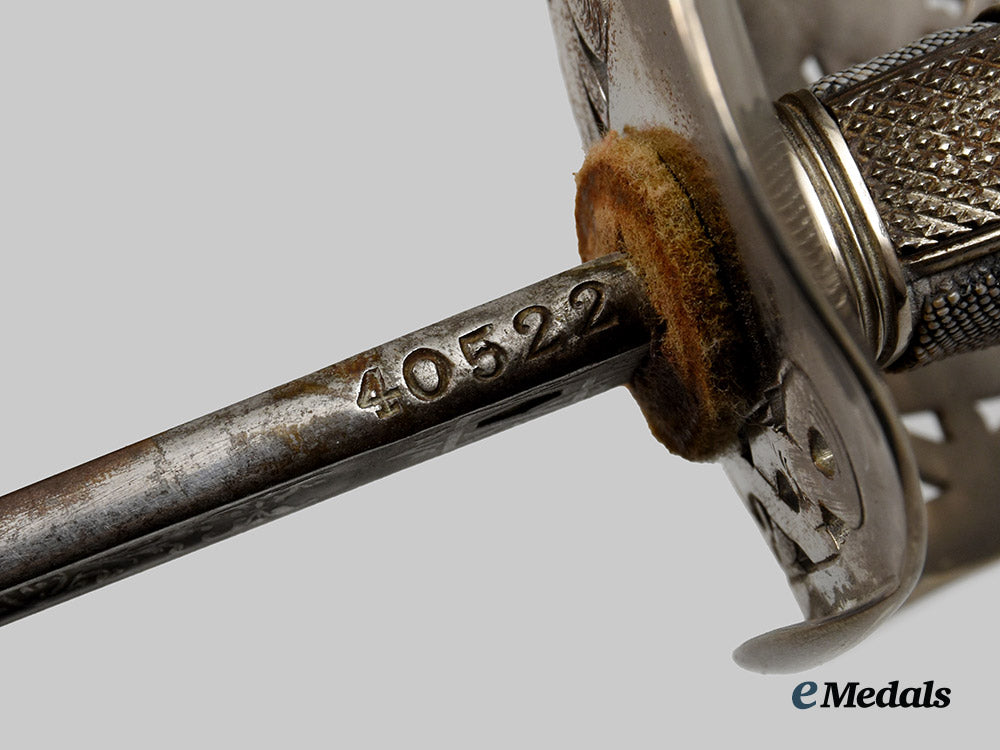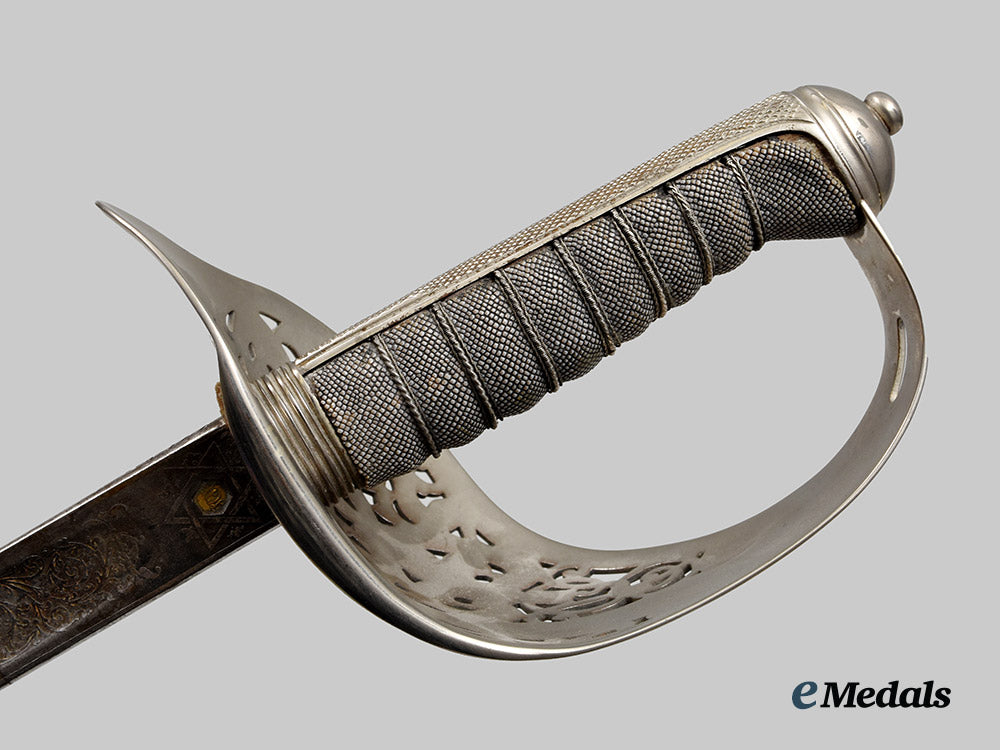
LOADING ...
In response to evolving domestic opinion, eMedals Inc has made the conscious decision to remove the presentation of German Third Reich historical artifacts from our online catalogue. For three decades, eMedals Inc has made an effort to preserve history in all its forms. As historians and researchers, we have managed sensitive articles and materials with the greatest of care and respect for their past and present social context. We acknowledge the growing sentiments put forth by the Canadian public and have taken proactive actions to address this opinion.














Canada, Dominion. A Rare Edward VII RMC Gentleman Cadet's Sword of Honour to Edward James Carson Schmidlin, CBE, DSO, MC
Canada, Dominion. A Rare Edward VII RMC Gentleman Cadet's Sword of Honour to Edward James Carson Schmidlin, CBE, DSO, MC
SKU: ITEM: M0428-127
Current Bid:
Your Max Bid:
Bid History:
Time Remaining:
Couldn't load pickup availability
Shipping Details
Shipping Details
eMedals offers rapid domestic and international shipping. Orders received prior to 12:00pm (EST) will be shipped on the same business day.* Orders placed on Canadian Federal holidays will be dispatched the subsequent business day. Courier tracking numbers are provided for all shipments. All items purchased from eMedals can be returned for a full monetary refund or merchandise credit, providing the criteria presented in our Terms & Conditions are met. *Please note that the addition of a COA may impact dispatch time.
Shipping Details
eMedals offers rapid domestic and international shipping. Orders received prior to 12:00pm (EST) will be shipped on the same business day.* Orders placed on Canadian Federal holidays will be dispatched the subsequent business day. Courier tracking numbers are provided for all shipments. All items purchased from eMedals can be returned for a full monetary refund or merchandise credit, providing the criteria presented in our Terms & Conditions are met. *Please note that the addition of a COA may impact dispatch time.
Description
Description
This sword features a polished nickel-plated steel blade, magnetic, with a semi-sharp tip. Both sides of the blade have a fuller running from the mid-point to just above the ricasso and incorporates an ornate floral pattern. The sword is serial numbered "40522" on the wide spine where it butts the grip. The obverse of the blade is emblazoned with the badge of the Royal Military College of Canada and surmounted by the royal crown, with a ribbon banner inscribed "TRUTH DUTY VALOUR" above and a ribbon banner inscribed "ROYAL MILITARY COLLEGE CANADA" below the badge. The reverse of the blade is inscribed "ROYAL MILITARY COLLEGE OF CANADA / PRIZE FOR DRILLS AND EXERCISES / GENTLEMAN CADET EDWARD JAs. CARSON SCHMIDLIN.". The obverse ricasso bears the Wilkinson Sword proof mark, while the reverse ricasso has the royal coat-of-arms, with a ribbon banner bearing the inscription "BY WARRANT" above the maker mark "HENRY WILKINSON / PALL MALL (LONDON)". It exhibits surface wear and contact marks from active use from the mid-point to the tip, with some wear and cleaning residue evident on the remainder of the blade, measuring 820 mm in length. The blade is embedded into the hilt and is firm to it, with an oval light brown leather washer surrounding the blade and resting upon the guard. The guard is also of a polished nickel-plated steel, magnetic, emblazoned with the Edward VII monogram and incorporates a voided floral pattern design. The ferrule butts the guard, the adjoining grip consisting of a wide nickel-plated spine integrating a pebbled pattern on the spine, the grip itself a simulated fish skin style and incorporates seven strands of silvered wire in the recessed areas, each of which consists of a single row of rolled wire flanked by twisted wire on either side. The grip is finished with a pommel that is topped by a prominent button, the entire sword inclusive of its blade and handle measuring 975 mm in length, with wear present on the guard. The sword is housed in its original nickel-plated steel field service scabbard, the opening featuring a matching steel throat, the body incorporating two large rings for suspension from a belt, along with a flattened u-shaped chape. It exhibits the usual contact marks and moderate surface wear from active use, the scabbard measuring 850 in length. Better than fine.
Footnote: Edward James Carson Schmidlin was born on August 18, 1884 in Brantford, Brant Country, Ontario. He was educated in Brantford where he attended Central School and Brantford Collegiate Institute. Following his graduation, he became a Cadet with the Royal Military College of Canada, where he won this Sword of Honour and the Governor-General's Gold medal, along with a scholarship to Chatham Barracks in England. Upon graduation from RMC, he received a commission in the Royal Engineers as a Second Lieutenant on June 22, 1905, then promoted to Lieutenant in the Canadian Engineers on February 9, 1910. In November 1914, Schmidlin was appointed Adjutant of the 2nd Canadian Divisional Engineers in the rank of Captain.
He saw service in the British Army in India and the Royal Canadian Engineers during the First World War. Schmidlin signed his CEF Attestation Paper in the rank of Captain with the Royal Canadian Engineers, on April 15, 1915 in Ottawa, Ontario, naming his next-of-kin as his wife, Wlihelmina Schmidlin of Ottawa, stating that he was with an Active Militia, that he had five years' service with the Royal (Canadian) Engineers, that he was married, that his religion was Weslayan and his trade as that of being with the Permanent Force. He arrived in France in September 1915 and served in that appointment until July 1917, when he was assumed the rank of Major, then Brevet Lieutenant-Colonel on May 24, 1918 (CE). He was appointed to command No. 12 Field Company, Canadian Engineers, ending the war as Commanding Officer of the 8th Battalion, Canadian Engineers.
For exploits performed as a company commander, he was awarded the Military Cross in the rank of Captain at Headquarters, Divisional Engineers, 12th Battalion, as part of the New Year's Honours list, the announcement appearing in the Third Supplement to the London Gazette 29886 of Friday, December 29, 1916, on Monday, January 1, 1917, page 45. In addition, he was Mentioned in Despatches in the rank of Lieutenant-Colonel at Headquarters, Divisional Engineers, 12th Battalion, the announcement appearing in the Eighth Supplement to the London Gazette 31448 of Tuesday, July 8, 1919, on July 11, 1919, page 8817.
Between the wars, Schmidlin continued to serve with the Canadian Engineers, becoming a Major on April 1, 1920 (RCE). After he returned to Canada in October 1921, he was appointed Professor of Military Engineering at the Royal Military College of Canada in Kingston, Ontario, where he later became Senior Professor and Professor of Engineering in September 1926. He was Director of Engineering Services at NDHQ in January 1934, promoted to Lieutenant-Colonel on July 1, 1936 (RCE), Colonel on August 14, 1938 (Military Staff) and Temporary Brigadier on August 15, 1938 (Military Staff).
During the Second World War, Schmidlin moved to Ottawa, where he became Director of Engineering Services for the Canadian Army, appointed Acting Quartermaster-General in April 1940, then named Quartermaster-General, with the rank of Major-General on July 24, 1940. The latter part of his career saw him becoming a Professor of Mechanical Engineering at Queen's University in Kingston, from 1942 until his retirement in 1946. He was once described as "a Brilliant Mechanical Engineer who knew so much that he couldn’t understand why others couldn’t understand” and by all accounts was very well respected. Major-General Edward James Carson Schmidlin, MC died on October 14, 1951 in Napanee, Ontario enroute from his home at Adolphustown to Kingston. He is buried in Saint Alban the Martyr Anglican Church & Cemetery in Adolphustown, Lennox and Addington County, Ontario and was survived by his widow, Wilhelmina Schmidlin (nee Moore, 1892-1961), the couple having a son, Major Lawrence Schmidlin, RCE.
Description
This sword features a polished nickel-plated steel blade, magnetic, with a semi-sharp tip. Both sides of the blade have a fuller running from the mid-point to just above the ricasso and incorporates an ornate floral pattern. The sword is serial numbered "40522" on the wide spine where it butts the grip. The obverse of the blade is emblazoned with the badge of the Royal Military College of Canada and surmounted by the royal crown, with a ribbon banner inscribed "TRUTH DUTY VALOUR" above and a ribbon banner inscribed "ROYAL MILITARY COLLEGE CANADA" below the badge. The reverse of the blade is inscribed "ROYAL MILITARY COLLEGE OF CANADA / PRIZE FOR DRILLS AND EXERCISES / GENTLEMAN CADET EDWARD JAs. CARSON SCHMIDLIN.". The obverse ricasso bears the Wilkinson Sword proof mark, while the reverse ricasso has the royal coat-of-arms, with a ribbon banner bearing the inscription "BY WARRANT" above the maker mark "HENRY WILKINSON / PALL MALL (LONDON)". It exhibits surface wear and contact marks from active use from the mid-point to the tip, with some wear and cleaning residue evident on the remainder of the blade, measuring 820 mm in length. The blade is embedded into the hilt and is firm to it, with an oval light brown leather washer surrounding the blade and resting upon the guard. The guard is also of a polished nickel-plated steel, magnetic, emblazoned with the Edward VII monogram and incorporates a voided floral pattern design. The ferrule butts the guard, the adjoining grip consisting of a wide nickel-plated spine integrating a pebbled pattern on the spine, the grip itself a simulated fish skin style and incorporates seven strands of silvered wire in the recessed areas, each of which consists of a single row of rolled wire flanked by twisted wire on either side. The grip is finished with a pommel that is topped by a prominent button, the entire sword inclusive of its blade and handle measuring 975 mm in length, with wear present on the guard. The sword is housed in its original nickel-plated steel field service scabbard, the opening featuring a matching steel throat, the body incorporating two large rings for suspension from a belt, along with a flattened u-shaped chape. It exhibits the usual contact marks and moderate surface wear from active use, the scabbard measuring 850 in length. Better than fine.
Footnote: Edward James Carson Schmidlin was born on August 18, 1884 in Brantford, Brant Country, Ontario. He was educated in Brantford where he attended Central School and Brantford Collegiate Institute. Following his graduation, he became a Cadet with the Royal Military College of Canada, where he won this Sword of Honour and the Governor-General's Gold medal, along with a scholarship to Chatham Barracks in England. Upon graduation from RMC, he received a commission in the Royal Engineers as a Second Lieutenant on June 22, 1905, then promoted to Lieutenant in the Canadian Engineers on February 9, 1910. In November 1914, Schmidlin was appointed Adjutant of the 2nd Canadian Divisional Engineers in the rank of Captain.
He saw service in the British Army in India and the Royal Canadian Engineers during the First World War. Schmidlin signed his CEF Attestation Paper in the rank of Captain with the Royal Canadian Engineers, on April 15, 1915 in Ottawa, Ontario, naming his next-of-kin as his wife, Wlihelmina Schmidlin of Ottawa, stating that he was with an Active Militia, that he had five years' service with the Royal (Canadian) Engineers, that he was married, that his religion was Weslayan and his trade as that of being with the Permanent Force. He arrived in France in September 1915 and served in that appointment until July 1917, when he was assumed the rank of Major, then Brevet Lieutenant-Colonel on May 24, 1918 (CE). He was appointed to command No. 12 Field Company, Canadian Engineers, ending the war as Commanding Officer of the 8th Battalion, Canadian Engineers.
For exploits performed as a company commander, he was awarded the Military Cross in the rank of Captain at Headquarters, Divisional Engineers, 12th Battalion, as part of the New Year's Honours list, the announcement appearing in the Third Supplement to the London Gazette 29886 of Friday, December 29, 1916, on Monday, January 1, 1917, page 45. In addition, he was Mentioned in Despatches in the rank of Lieutenant-Colonel at Headquarters, Divisional Engineers, 12th Battalion, the announcement appearing in the Eighth Supplement to the London Gazette 31448 of Tuesday, July 8, 1919, on July 11, 1919, page 8817.
Between the wars, Schmidlin continued to serve with the Canadian Engineers, becoming a Major on April 1, 1920 (RCE). After he returned to Canada in October 1921, he was appointed Professor of Military Engineering at the Royal Military College of Canada in Kingston, Ontario, where he later became Senior Professor and Professor of Engineering in September 1926. He was Director of Engineering Services at NDHQ in January 1934, promoted to Lieutenant-Colonel on July 1, 1936 (RCE), Colonel on August 14, 1938 (Military Staff) and Temporary Brigadier on August 15, 1938 (Military Staff).
During the Second World War, Schmidlin moved to Ottawa, where he became Director of Engineering Services for the Canadian Army, appointed Acting Quartermaster-General in April 1940, then named Quartermaster-General, with the rank of Major-General on July 24, 1940. The latter part of his career saw him becoming a Professor of Mechanical Engineering at Queen's University in Kingston, from 1942 until his retirement in 1946. He was once described as "a Brilliant Mechanical Engineer who knew so much that he couldn’t understand why others couldn’t understand” and by all accounts was very well respected. Major-General Edward James Carson Schmidlin, MC died on October 14, 1951 in Napanee, Ontario enroute from his home at Adolphustown to Kingston. He is buried in Saint Alban the Martyr Anglican Church & Cemetery in Adolphustown, Lennox and Addington County, Ontario and was survived by his widow, Wilhelmina Schmidlin (nee Moore, 1892-1961), the couple having a son, Major Lawrence Schmidlin, RCE.














You May Also Like
Germany, SA. A Model 1933 Service Dagger, SA-Gruppe Nordsee, by Friedrich von der Kohlen
G59818
Germany, SA. A Model 1933 Service Dagger, SA-Gruppe Pommern, by Gustav Wirth
G59816
Germany, Third Reich. A Mixed Lot of Tyrolean Marksmanship Badges
G52930
Germany, SS. An Estonian Waffen-SS Volunteer’s Sleeve Shield
G50381
Germany, SS. A Waffen-SS Sturmmann Sleeve Insignia
G52846
-
Germany, SA. A Model 1933 Service Dagger, SA-Gruppe Nordsee, by Friedrich von der Kohlen
G59818
Add to CartRegular price $980 USDRegular price $0 USD Sale price $980 USDUnit price / per -
Germany, SA. A Model 1933 Service Dagger, SA-Gruppe Pommern, by Gustav Wirth
G59816
Add to CartRegular price $980 USDRegular price $0 USD Sale price $980 USDUnit price / per -
Germany, Third Reich. A Mixed Lot of Tyrolean Marksmanship Badges
G52930
Add to CartRegular price $135 USDRegular price $0 USD Sale price $135 USDUnit price / per -
Germany, SS. An Estonian Waffen-SS Volunteer’s Sleeve Shield
G50381
Add to CartRegular price $150 USDRegular price $0 USD Sale price $150 USDUnit price / per -
Germany, SS. A Waffen-SS Sturmmann Sleeve Insignia
G52846
Add to CartRegular price $135 USDRegular price $0 USD Sale price $135 USDUnit price / per
Do you have a similar item you are interested in selling?
Please complete the form and our client care representatives will contact you.
Sell Item
































